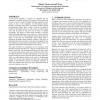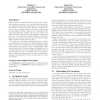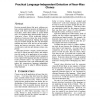33 search results - page 2 / 7 » Tool Demonstration: Finding Duplicated Code Using Program De... |
EUROPAR
2010
Springer
13 years 8 months ago
2010
Springer
Manual parallelization of programs is known to be difficult and error-prone, and there are currently few ways to measure the amount of potential parallelism in the original sequent...
ACMSE
2006
ACM
13 years 9 months ago
2006
ACM
A code clone represents a sequence of statements that are duplicated in multiple locations of a program. Clones often arise in source code as a result of multiple cut/paste operat...
CCS
2009
ACM
14 years 2 months ago
2009
ACM
Software flaws in native methods may defeat Java’s guarantees of safety and security. One common kind of flaws in native methods results from the discrepancy on how exceptions...
ICSE
2009
IEEE-ACM
14 years 8 months ago
2009
IEEE-ACM
Code cloning is not only assumed to inflate maintenance costs but also considered defect-prone as inconsistent changes to code duplicates can lead to unexpected behavior. Conseque...
CASCON
2004
13 years 8 months ago
2004
Previous research shows that most software systems contain significant amounts of duplicated, or cloned, code. Some clones are exact duplicates of each other, while others differ ...



